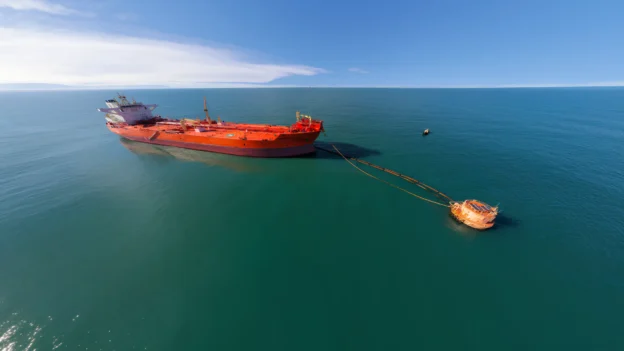Table of Contents
Artificial intelligence to enhance efficiency and safety in ship mooring, remote real-time monitoring of equipment positioning via GPS, collision protection and alert technology, and the use of ROVs for underwater inspections: Transpetro, the largest multimodal logistics company for oil and derivatives in Latin America, has no shortage of innovative and exclusive solutions already adopted or on its radar for its marine monobuoy system. Technology will increasingly play a role, as the company continually invests to meet future challenges and expand its multimodal logistics system.
The scale of Transpetro’s operations in the marine monobuoy system justifies this strategy. Last year, the company handled over 25.7 million cubic meters of products through these floating terminals, where oil tankers dock for loading and unloading. In 2025, the trend of expansion has remained steady, with over 10.6 million cubic meters moved in just the first five months of the year.
Currently, the company operates four marine monobuoys: two in Tramandaí (RS), one in São Francisco do Sul (SC), and one in Northern Espírito Santo (near the city of São Mateus).
The marine monobuoy system in Southern Brazil is crucial for the entry of oil and derivatives that supply the refineries servicing the region’s fuel market, while the one in Northern Espírito Santo is responsible for the evacuation of terrestrial production in the area.
Artificial Intelligence
Transpetro has been using artificial intelligence (AI) for ship mooring since 2021. Through continuous testing, the tool achieved 92% accuracy in 2024, becoming a benchmark in this type of innovation. The goal is always to provide decision support, offering maneuvering captains, managers, and logistics teams a quantitative analysis of a ship’s docking probability and the subsequent supply to the market.
This innovation is already being studied for other applications, such as ship-to-ship and port operations, as well as for predicting pier maintenance, among other possibilities.
Transpetro has installed current meters and wave buoys offshore, near the marine monobuoy system of the Southern terminals. With the implementation of these new instruments and the use of anemometers (meteorological devices that measure wind speed and direction) installed onshore, it is possible to calibrate this new tool, increasing its accuracy. This real-time approach significantly enhances the safety and efficiency of operations, providing decision support to the maneuvering pilot.
Other Solutions
Transpetro has been testing the use of Mini ROVs (Remotely Operated Vehicles) to assist in underwater visual inspections. This technology will enable inspections of the equipment that is part of the underwater marine monobuoys, even under adverse conditions, reinforcing the commitment to increasingly safe operations.
In addition to this tool, the use of GPS (Global Positioning System) installed on the single point mooring allows for real-time tracking of its position, while the AIS (Automatic Identification System) creates a virtual “fence” around the structure, alerting to possible collision risks from nearby vessels.
For maintenance, repair, and decommissioning services of marine monobuoys, Transpetro conducts periodic evaluations and assesses intervention needs on a case-by-case basis.
These exclusive innovative solutions provide logistical benefits to the company and to Brazil, particularly in the Southern Region, while also considering the potential for scaling. Transpetro possesses the intellectual capital necessary to enhance and expand its use in different contexts.
This article was developed by specialist Adriana Andrade and published as part of the fifth edition of Inspenet Brief magazine August 2025, dedicated to technical content in the energy and industrial sector.

